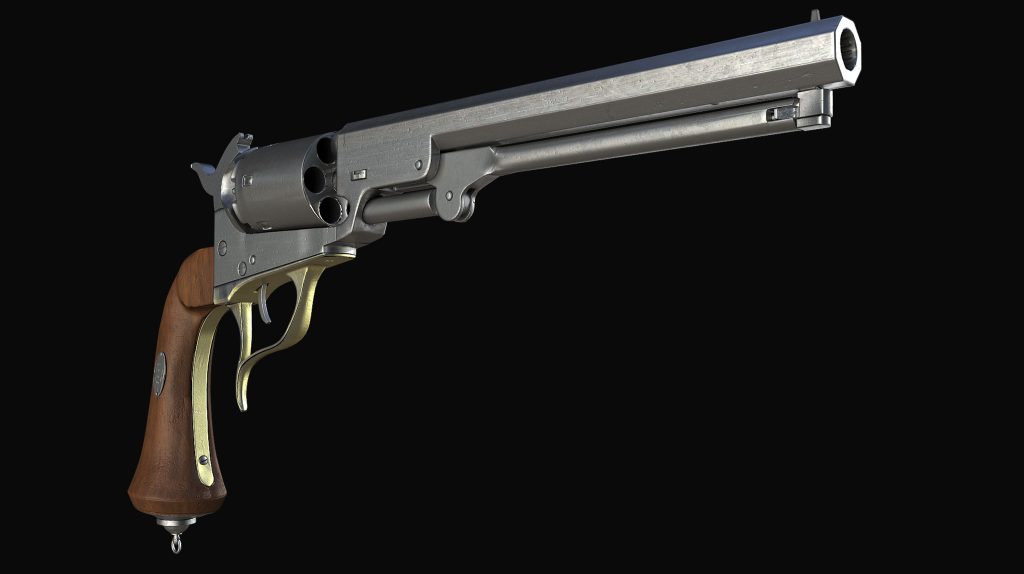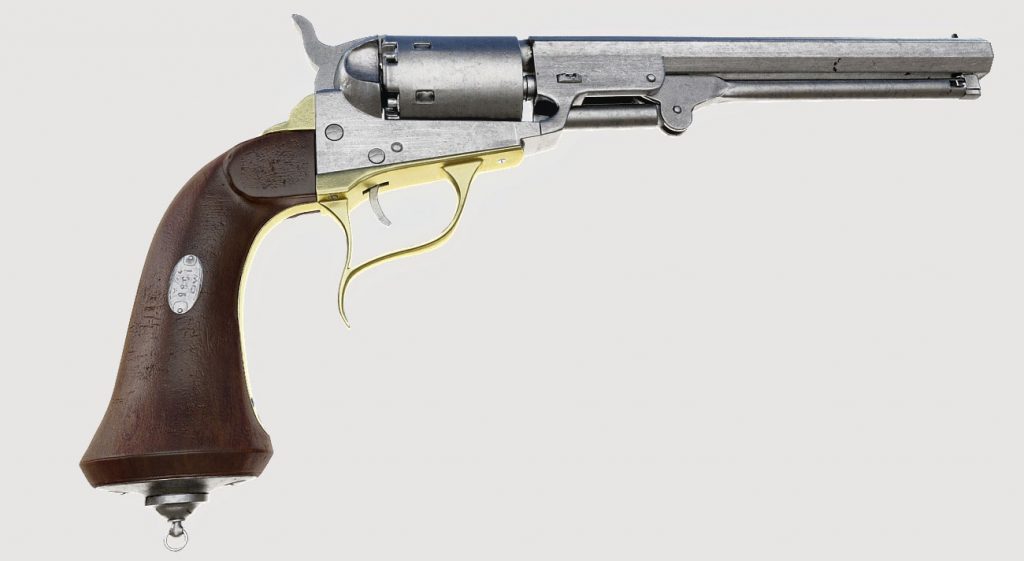Specifications
Revolver caliber – 9 mm, revolver barrel length – 19 cm, revolver length – 35.5 cm, revolver weight – 1.2 kg, 6 special grooves in the barrel, cylinder capacity – 6 rounds, muzzle velocity – 270 m/s, maximum shooting range – 59 m.
Operating principle
To load a revolver half-cock the hammer for the cylinder to rotate freely. Rotating the cylinder, put caps on nipples in succession. Insert the rounds into special chambers, from the inner side of the original cylinder. Unique rounds were made of a paper sleeve that contained the required charge and a heavy lead bullet. Seal the round in the cylinder chamber with a rod.
Full-cock the hammer to fire a shot. When the hammer is being cocked, the revolver’s cylinder rotates fitting the next chamber to the barrel and fixing in that position. The folding trigger is protracted simultaneously with cylinder rotation for one chamber.
History of the specimen
The exhibition shows a Colt revolver manufactured at the factory of the Tula craftsman Petr Goltyakov. He made the revolver adhering to the main rules applicable to the weapon type. The wooden grip is slightly widened downwards for ease of revolver holding. Each cylinder chamber has its own recession for loading the rounds. A folding trigger is in the bottom part of the revolver body. Right under the octangular barrel there’s a special lever on a swivel to help fix the cylinder.
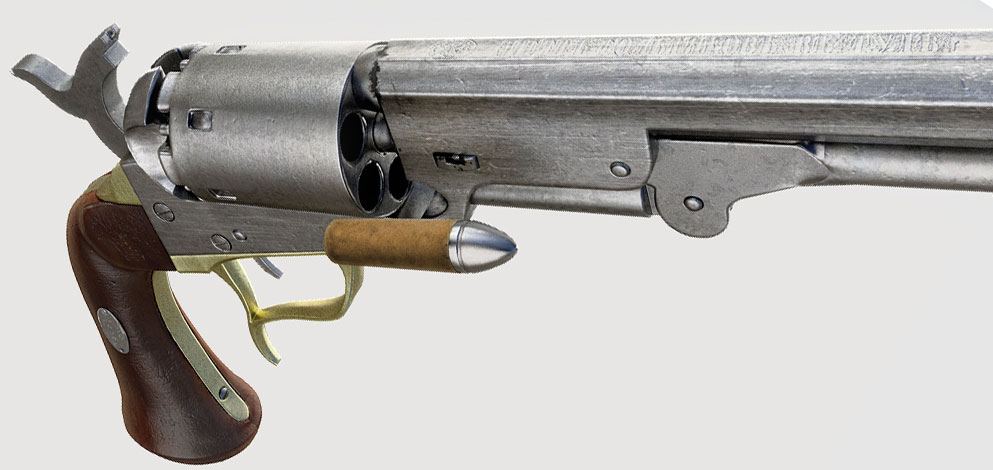
Distinctions between original US-made revolver and models manufactured by Tula gunsmiths. Particularly different is the grip shape; in Tula models it has a special lug with a lanyard ring. The trigger guard from domestic artisans can additionally rest the middle finger. Tula-made weapons specimens have 6 rifles in the revolver main bore, whereas US-made had 7 rifles with a different pitch.
Development
The first US-made revolver models emerged as far back as the 16th century. That period is described as the early stage of handguns development for personal use.
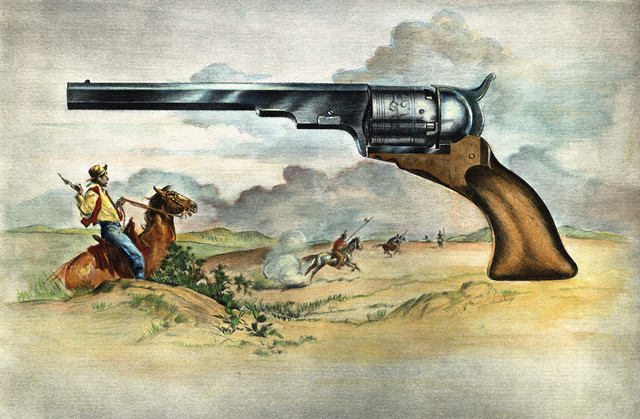
In Russia the craftsmen of Tula manufactured various models of original flintlock revolvers with custom-made cylinders for ammunition already in late 18th century.
Development of cap and ball revolvers reached its heyday in the second half of the 19th century. Samuel Colt, an American entrepreneur, became a most prominent weapons designer and inventor of the era.
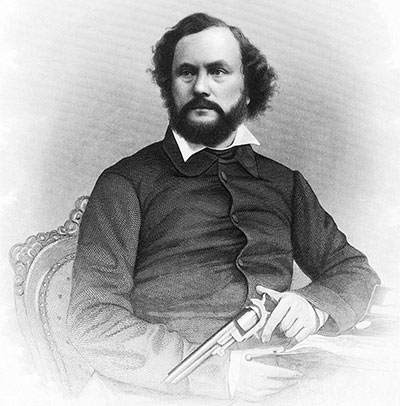
Revolver backstory
Mr. Colt’s parents recalled that he received a toy pistol on his 4th birthday. He stealthily took powder from his father and loaded it into the pistol. An explosion occurred, fortunately without any tragic consequences for the young Colt himself. This is deemed to be the point of time when Colt trod the path of a gunsmith.
He got a rifle at the age of 12, and instead of firing a shot he started disassembling and assembling the weapons trying to grasp how it worked.
Later on, Sam got a sailor’s job in a marine commercial route. While at sea, he tried to invent a galvanic battery to detonate underwater mines. The presentation proved to be a failure and potential investors had to leave the site being wet from head to foot.
During his voyages irrepressible Colt devised a pistol with a revolving cylinder mechanism.
It would though be just to note that similar structures had existed before. For instance, as far back as 1597, German blacksmith and inventor Hans Stoppler offered a design which is now classified as a revolver.
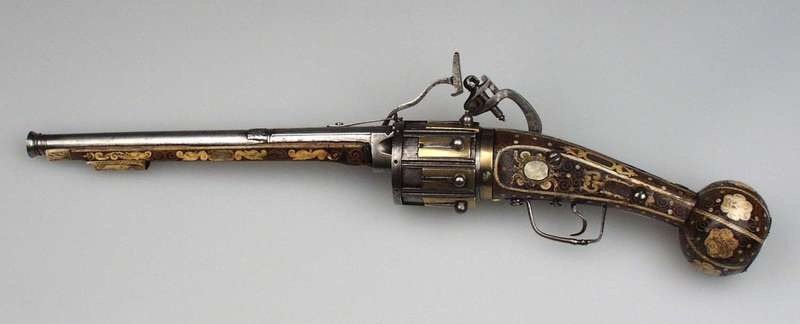
But it was Colt who managed to make this weapon reliable, simple and genuinely widespread.
The odd thing is that to implement his idea Colt set up a bunch of businesses to quickly raise money. Colt would likely be called an audacious entrepreneur presently. Thus, one of his companies was testing the laughing gas. Generally, Colt went bankrupt a number of times, but invariably revived and got back to his business.
The enterprises helped him earn money, and the first model with a wooden cylinder was made by gunsmith John Pearson.
 Road to success
Road to success
The incident with Captain Jack Hays became the next pivotal point in the life of Colt. Hays and 15 of his rangers managed to counter to nearly 50 of Comanches, having killed 35 Indians in the fight. After that occasion Colt obtained a spate of orders.
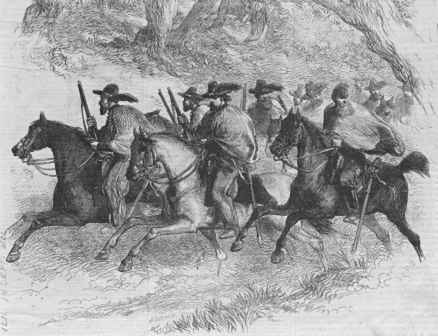
The U.S. – Mexican War came to be a great piece of luck for Colt. The state ordered 1,000 revolvers and continued placing big orders throughout the war.
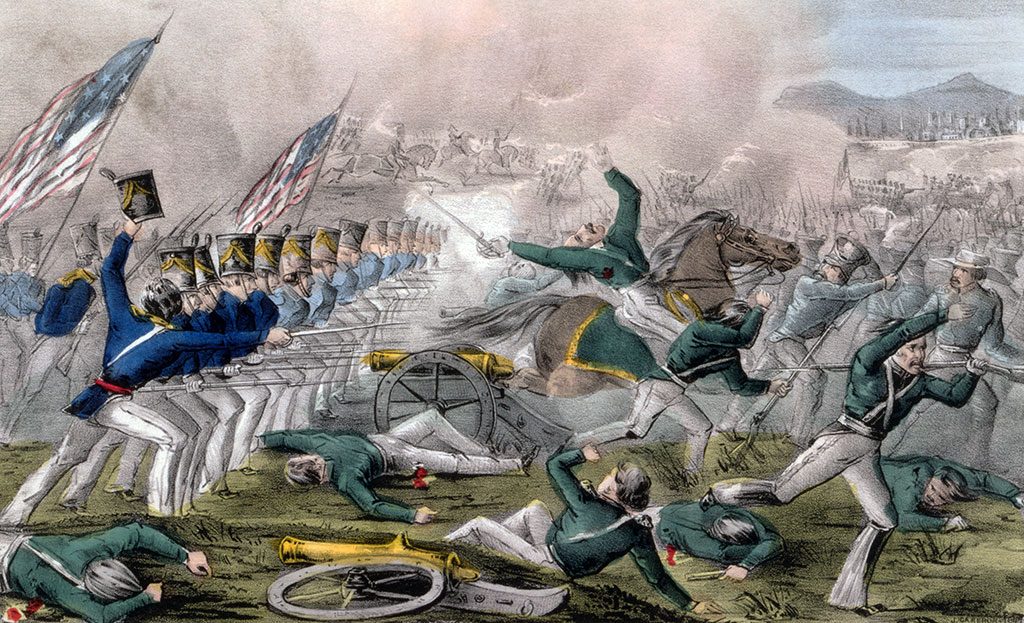 The golden rush turned to Colt’s pot of gold. The prospectors bought his items on a large scale due to low price and efficiency.
The golden rush turned to Colt’s pot of gold. The prospectors bought his items on a large scale due to low price and efficiency.
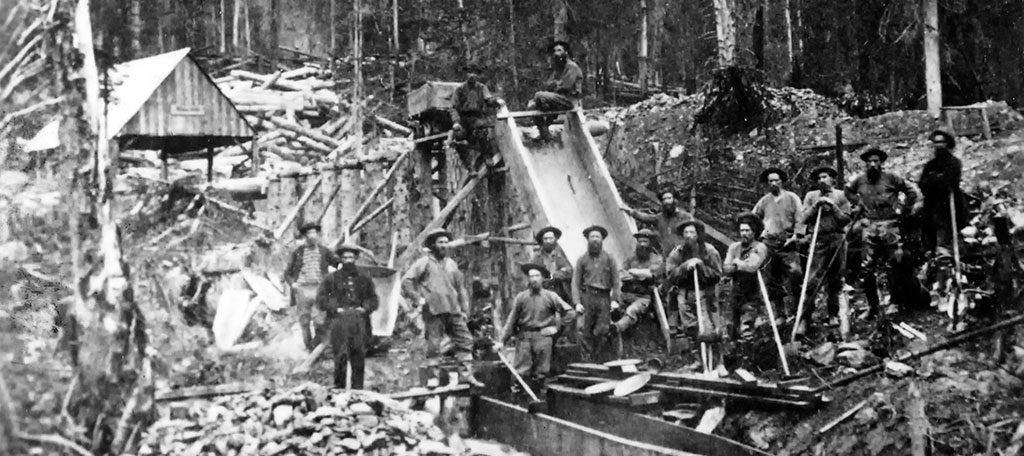
Colt’s manufacturing system
To manufacture weapons on such a grand scale Colt pioneered in the proprietary arms making, and adopted severe standardization. In 1835 Colt built his own factory that manufactured 6 shooter revolvers. Already in 1848 Samuel Colt expanded his manufacture and arranged simultaneous production of several revolver models at a factory in Hartford. The 1851 Navy Revolver was among the most popular weapons at the time.
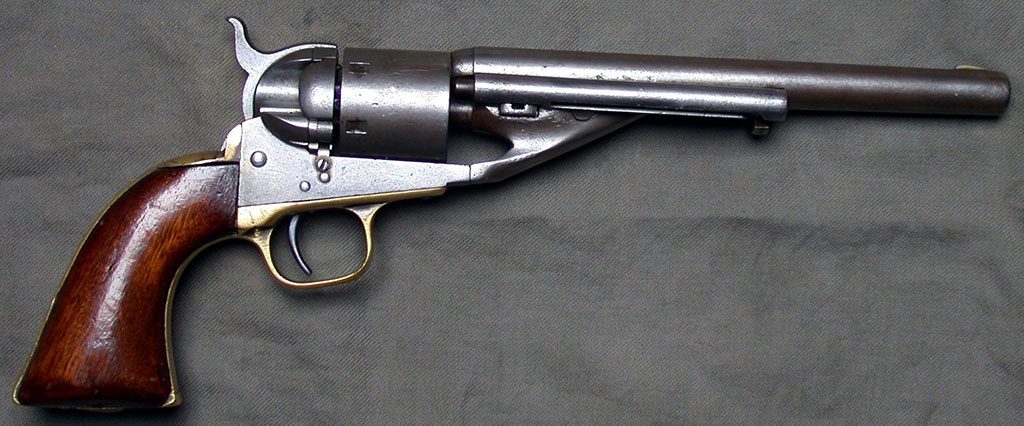
All original revolver models were traditionally made manually by artisans. Such manufacturing method brought small batches made by the skillful craftsmen. All governmental organizations that produced original revolvers were strictly adjusting the line and definite templates for production. The watchdogs demanded that similar arms making methods and technologies were used.

Being an inventor and a successful businessman, Colt realized the point of process-based approach to arms manufacturing, giving preference to automated manufacturing lines. He knew such an approach towards creation of original revolver models would enable to drastically cut the product cost, and be good for company’s total profit. These innovative solutions resulted in drastic decline of the product cost. Thus, soon after being launched into production an original Colt revolver cost $50, and already in 1859 only $19, due to colossal scale of manufacture.
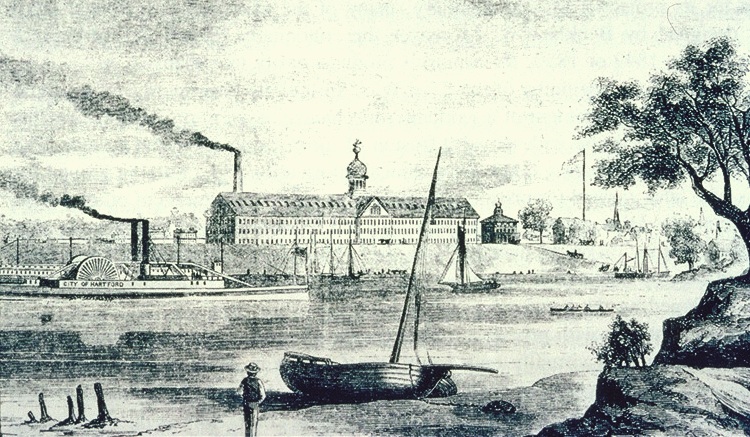
Colt managed to set up the large-scale arms manufacture at his own factory in Hartford, where all phases were clearly divided into 450 individual manufacturing operations. The scale of manufacturing attracted tons of tourists and all those concerned to the unique factory.
 Use
Use
Russian Army officers were first able to try unique Colt revolvers only in 1842, when visiting the arms factory in Paterson. In a while, those revolver models became freely sold in the domestic market. The large numbers of U.S. models available on the market included some revolvers from the Tula gunsmiths.
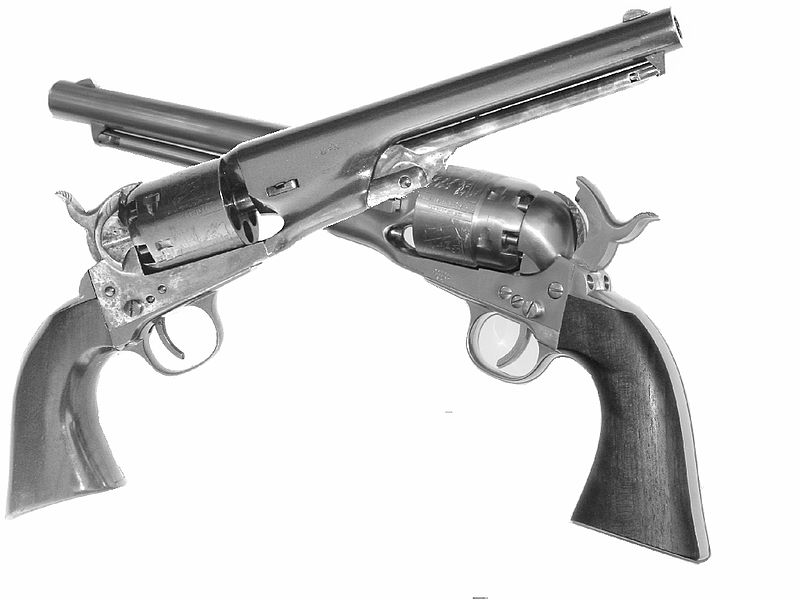
Ruler Nicholas I and designer Samuel Colt met at the renowned Winter Palace of St. Petersburg in late 1854. The designer presented to the monarch 3 luxurious revolvers with custom-made precious decorations. To Colt’s amazement the emperor was not surprised by the weapons; the entrepreneur’s attempt to secure an order for delivery of his proprietary weapons failed.
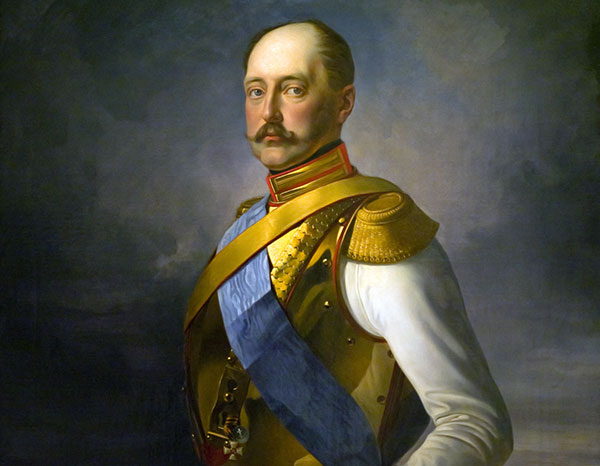
Original revolvers were never used as standard weapons in the Russian Army. However, all regular officers were by word of mouth recommended to buy the revolvers at their own expense. In Russia the revolvers were manufactured by private gun shops, including by the Tula arms factory.
Original Colt revolvers were widely used at the Russian Navy. In early 1854 sophisticated Tula gunsmiths presented to Nicholas I a proprietary designed Colt revolver. The emperor then ordered to produce 400 such revolvers for the naval crews, and for all officers of the detached rifle regiment of imperial guards. The order was completed by the end of the same year.
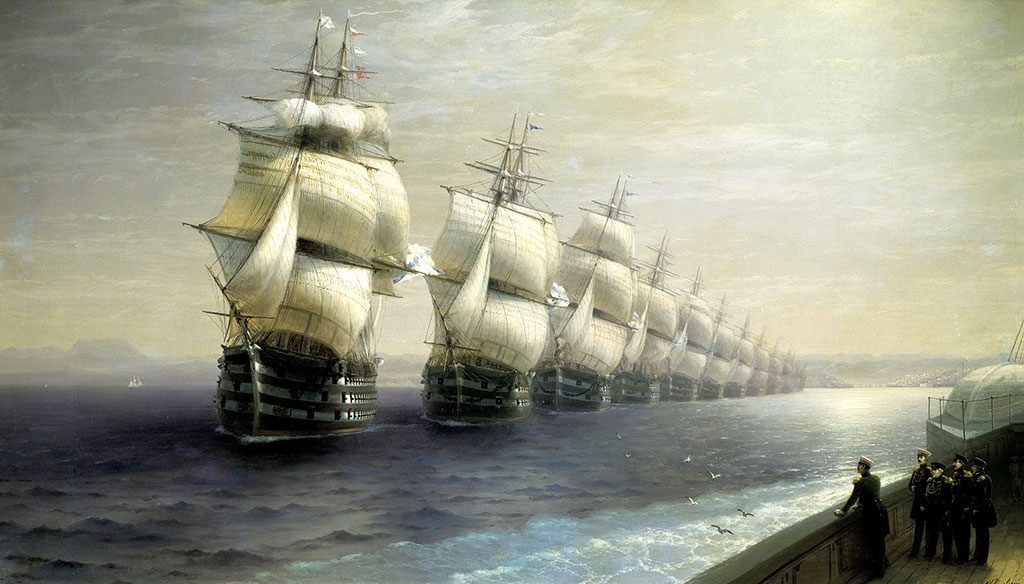
Tula gunsmith Nikolai Goltyakov created a unique model of his own design, that fully met the U.S. peer. This particular model is offered in the game.
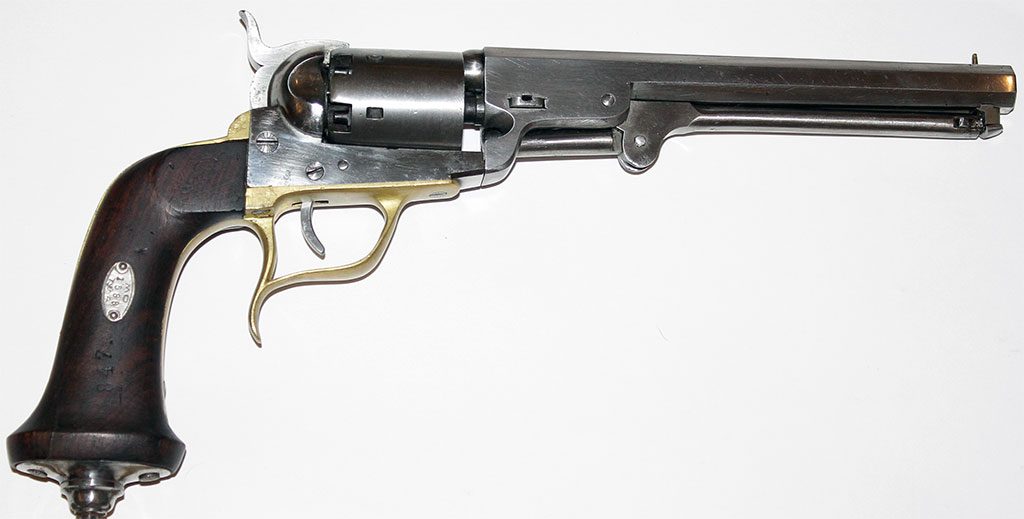
Over time, the cap and ball revolvers were superseded by more sophisticated models for cartridges.
